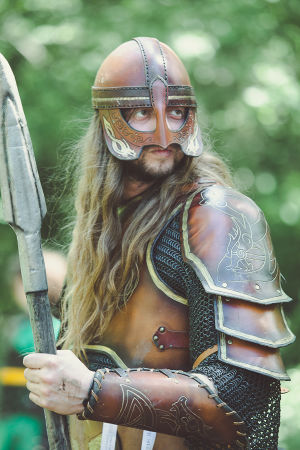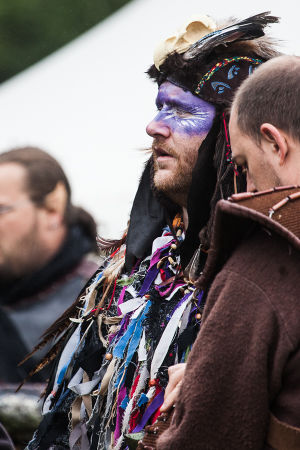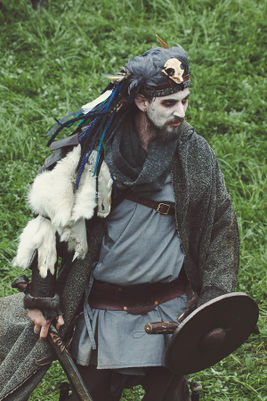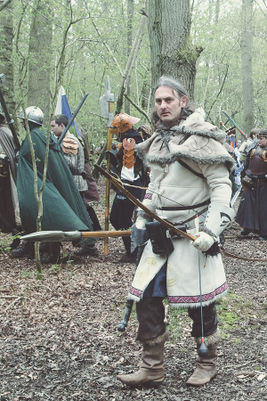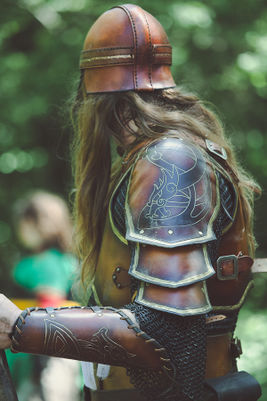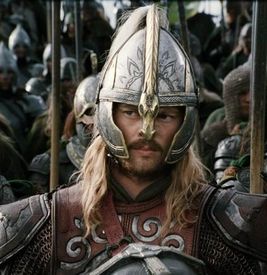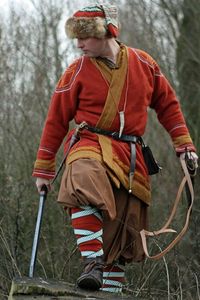Wintermark look and feel
CharlotteM (talk | contribs) mNo edit summary |
CharlotteM (talk | contribs) mNo edit summary |
||
| Line 90: | Line 90: | ||
<row-fluid> | <row-fluid> | ||
<span12> | <span12> | ||
{{CaptionedImage|file= | {{CaptionedImage|file=CM-140418-5800.jpg|width=267}} | ||
</span12> | </span12> | ||
</row-fluid> | </row-fluid> | ||
Revision as of 10:43, 9 July 2014
Overview
The Wintermark look is rugged and practical, but strives to express the wearer's individuality. As a nation, the Winterfolk are expert craftsmen, who take immense pride in their work and treat complex runic sigil-work as a necessary part of every piece they make.
Winterfolk art tends to be intricate and detailed. Stone, metal and wood are carved with runes, so craftsmen can show off their skills. The people of the Wintermark use bright scarlet for things like banners, because they can be seen for miles through snow and atop mountainsides.
The most common costume for the Winterfolk is a thigh-length tunic over trousers. The differences between the three traditions come in the way they add to and adorn this basic style.
Also see Wintermark Costumes and Wintermark Icons and Artistry.
Feel
Iron, hard, firm, strong, unmoving, earnest, craftsman, perfectionist, pragmatic (Steinr and Suaq), dreamer (Kallavesi), individual.
Breakdown
Winterfolk
Clothing
The basic Wintermark costume for men is a thigh-length tunic. The tunic can be linen or wool. Most Wintermark women wear the same or a close fitting dress. The Viking apron dress exists but is considered slightly old fashioned.
Tunics are worn over close fitting trousers, often with wrappings ankle to knee.
Armour
Heavy, layered armour with thick leather plates over chain.
Suaq
Influences
Think of Lapp reindeer herders and Inuit; independent scouts and hunters.
Materials
Furs and hides, ivory, scrimshaw carved bone items.
Colours
Light, washed out tones of cream, ivory, taupe, pale grey.
Clothing
Suaq often wear a long tight coat of animal skin (skin side out, fur side in) or lighter painted deerskins in warmer parts. Clothing is emblazoned with drawings and symbols of animals, which are usually painted on to the leather or material.
Armour
Adorn with heavy furs that offer protection against the cold.
Shields
Uncommon, but possibly leather stretched over wood.
Weapons
Hunting weapons, bows, spears, staves for crossing treacherous ice.
Steinr
Influences
Rohirrim, Tolkien’s Dwarves, Beowulf (2005), Saxons, Skyrim.
Materials
Metals, furs, leather, stone, woollen cloth; richer fabrics may be appropriate for high status Thanes.
Colours
Dark shades of green, blue, red and brown, also dark metals – iron, coppers, bronze.
Clothing
Steinr clothing is designed to show off the owner’s wealth. It may be dyed a bright colour, be intricately embroidered or have decorated hems in a contrasting colour or material. Clothing is often worn with jewellery with torcs and cloak pins common.
Armour
Heavy, layered armour (chain with dark leather/plate over), intricately decorated and personalised so each person’s kit looks different.
Shields
Ideally tear-drop shaped kite shields; round shields are an acceptable alternative.
Weapons
Long swords, spears, Dane axes - heavy and practical, decorated with runes.
Kallavesi
Influences
Finland, Kallevala, the Crannogmen from Game of Thrones. Bog-dwelling shamans.
Materials
Homespun checked Wool, linen, fur, leathers, wood and wicker, polished stones (semiprecious).
Colours
Greys, duns, moss, smoke, occcasional bright flashes of colour, dark feathers.
Clothing
Kallavesi costume often includes a cloak of wool or fur over the top of the traditional tunic. Garments use more drab colours and more worn looking fabric. They embellish their appearance with feathers, beads and fetishes and ideally an animal headdress of some kind.
Armour
Light leathers and furs.
Shields
Rare, but possibly small wicker bucklers.
Weapons
They carry axes, staves, fishing spears and gutting knives.
Steinr costume
Steinr tunics may be layered to show off hems that are decorated with a constrasting fabric or braid. Theoden’s costume from Lord of the Rings shows the sort of outfit a wealthy and powerful Thane might wear to display their prosperity - the tunic is made from a rich fabric that is intricately embroidered.
Kallavesi costume
Kallavesi clothing is the standard Wintermark tunic over trousers, often in a rougher woven fabric and embellished with furs and feathers. The Kallavesi wear furs with the fur side out. The stormcrow mystic wears the traditional ragged but heavy cloak and a costume adorned with tatters of material and fetishes. Feathers in particular are important to the Kallavesi and the Kallavesi shamans in particular.
Suaq costume
The heavy coats of the Suaq protect them against the cold. Reindeer and seal skins are turned fur side in for warmth. Ideally the heavy fur coats should be richly decorated with important symbols — designs of animals and enemies the warrior has killed. In warmer climates the coats may be leather and in the imperial heartland in summer they may chose to wear linen or canvas versions.
Steinr warriors
The Rohirrim in Lord of the Rings epitomise the Steinr warriors. Layered armour, leather or less commonly plate over mail, but with the armour intricately tooled and embellished.
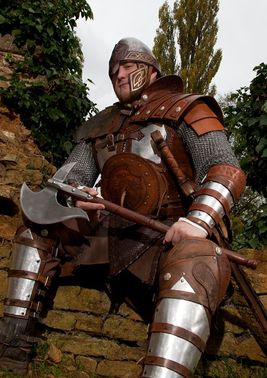
Suaq & KallavesI warriors
Kallavesi and Suaq warriors wear fur over mail or simply leather or fur by itself. The Kallavesi decorate their armour with feathers and beads and many wear an animal headdress. The Suaq paint their armour with symbolic designs of animals. F The bear heads were made by Evenlode Studio.
Shamans & Icewalkers
Kallavesi Shamans are practiced seers and mystics. Most supplement the normal Kallavesi dress with an animal headdress decorated with feathers and fur.
Suaq Icewalkers use their magic to complement their wits. They wear traditional Suaq clothing but supplemented with jewellery and amulets.
Children
Images to avoid
An LRP setting is defined as much by what you leave out as by what you include. In defining the Wintermark look we have actively chosen to exclude some elements. Please do not use any of the images or looks seen in this section. In particular please note that the Winterfolk were inspired by Saxons rather than Vikings and the setting does not include longships and the associated imagery.
